A Walk & Leap of Faith
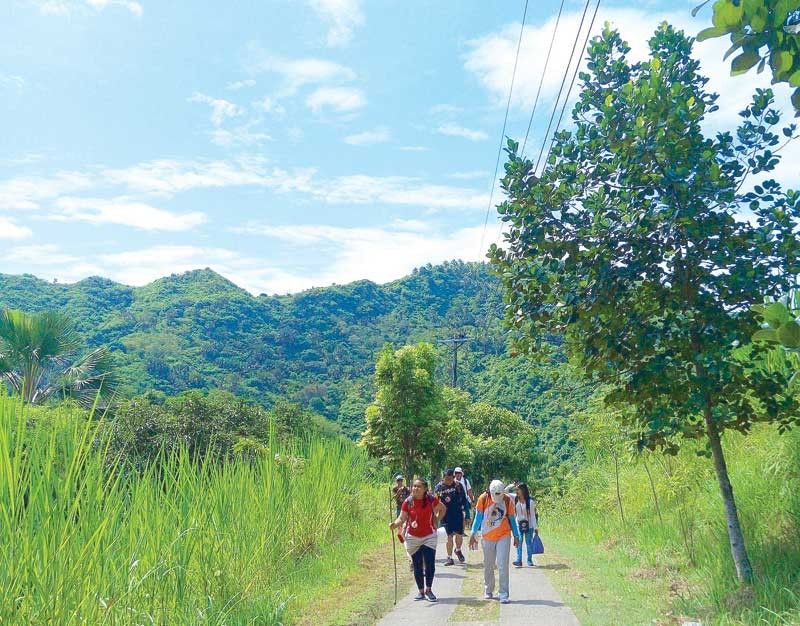
MANILA, Philippines — A tranquil hamlet by the sea will soon be the center of spiritual activity, thanks to the Archdiocesan Shrine of Señor Santiago Apostol de Compostela in the town, simply known as Compostela, on the island of Cebu.
Sooner than later, this venerated site will be swarmed with pilgrims – from all over the world and from all walks of life – on their own personal life-changing and soul-searching mission via the camino.
For many devotees, going on the Camino de Santiago Compostela in Spain is both a physical and a spiritual undertaking.
As a backgrounder, after the 812 AD discovery of St. James’ remains, the fabled Camino de Santiago began, where pilgrims traveled by foot or on horseback to follow several predetermined routes – as many as the imagination can bear – which crisscrossed country borders that pass through cities and towns, visited cathedrals and churches, found refuge in convents and monasteries – to the shrine of the apostle Saint James the Great in the cathedral of Santiago de Compostela in the province of Galicia in northwestern Spain, as the ultimate destination.
The early devotees relied on the hospitality and charity of foster homes and missions to provide a roof over their heads and nourishment as they only brought the barest essentials.

The main altar with the image of the patron saint surrounded by angels.
As a spiritual exercise, it offers a way to examine oneself despite several challenges – for the journey towards the self is a journey towards the God within, devouts firmly believe.
The El Camino de Santiago de Compostela Cebu – a “local poor-man’s version” of the foreign tradition – began with parish priest Fr. Scipio Deligero who pioneered the first 10-day trek in 2017. A year later, Fr. Gonzalo Candado headed a shorter 2-day trip.
And thus began the Philippine Camino.
The 10-day experience is a stretch of 180 kilometers traversing through select areas such as Badian, Argao, Dalaguette, Sibonga, Carcar, Barili, San Fernando, Naga City, Toledo City and several barangays of Cebu City, Consolation, Liloan and Compostela.
The newer 2-day walk, on the other hand, covers a 28-kilometer distance from Compostela through some Liloan barangays and back, and has been a crowd favorite.
In addition to the ever-present wooden staff, most, if not all, pilgrims carry with them a stone from home. It symbolizes one’s whole self – prayers, petitions, endeavors, concerns and other connotations based on one’s personal intentions. Some travelers may meet believers along the way who may likewise ask for prayers by surrendering their wishes written down on a piece of paper.
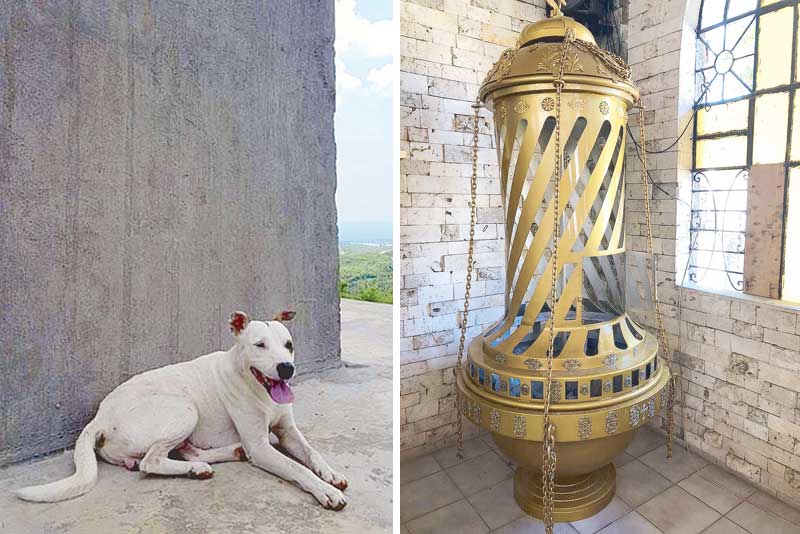
(Left) The Camino dog waits for new pilgrims to arrive. (Right) The 11.5-foot botafumeiro will soon be installed.
The small rock and parchment are set to be dropped at the foot of the Cross of Triumph in Bagalnga – approximately 8 kilometers away from the shrine – a vital element to the Camino experience here and abroad, which serves as another terminus before the end. A period of silence in the breathtaking view calms the mind and aids in further reflection.
The huge cross on a barren hill in Bagalnga was a promise by a returning resident from a pilgrimage in Jerusalem together with his wife, as a gift of gratitude for the unforgettable trip. While under construction, the spouse passed on, but it was completed to honor her memory.
“During the home stretch, several peregrinos are joined by a white dog – the owner and name unknown – that accompanies weary travelers until they reach the church. The canine then mysteriously disappears as quickly as it appeared,” narrates Fr. Vhen Fernandez, a fellow peregrino himself who serves at the Archdiocesan Shrine of Señor Santiago Apostol de Compostela.
Last Feb. 5 and 6, during the Second National Congress of Santiago Apostol Parishes and Devotees held in Compostela, Cebu, Rev. Jose Palma, the Archbishop of Cebu, and other church dignitaries, together with guests of honor Msgr. Elisardo Temperan Villaverde, the Chancellor and Secretary of the Cathedral Chapter of Santiago de Compostela, Spain, and Fr. Manny Domingo, Jr., chaplain to the English-speaking pilgrims, officially launched the Cebu Camino with prayers and blessings, which further solidified and accredited that all local peregrinos will receive the same indulgences had they accomplished it in Compostela, Spain.
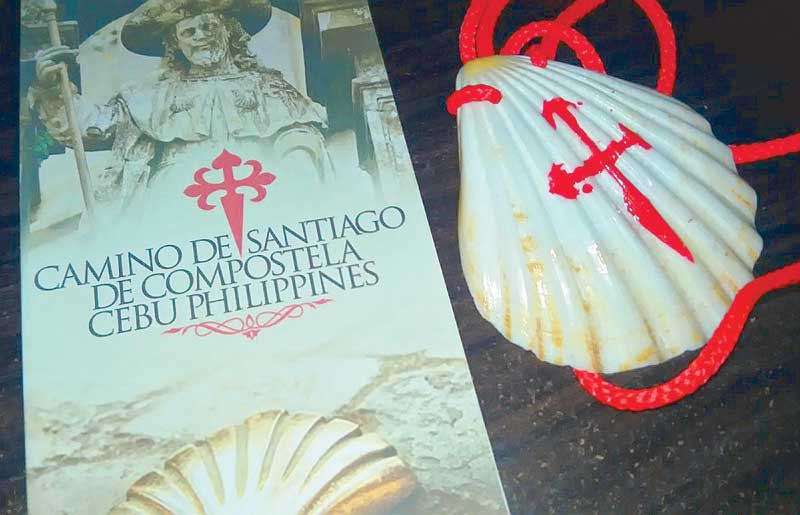
The shell necklace and booklet are souvenirs of the journey.
“Ang galing! It was so overwhelming. We saw the people and the local government in full force – together as one family!” Fr. Domingo exclaimed on the warm turnout of the all-important series of events.
Situated by the northeast coast some 20 kilometers from the capital, between the pueblo of Liloan – known for the historic lighthouse at Bagacay Port, its otap and barquillos, and Danao City – popular for its beach and mountain resorts and their bibingka, Compostela is a peaceful third class municipality with a little over 50,000 inhabitants.
Local history tells of an Augustinian Recollect friar named – depending on the source – Fr. Jose or Fr. Manuel Alonzo from Compostela in Spain, who brought an image of his city’s patron saint when he sailed for his conversion mission, where he formally established the wee chapel in 1865. It was elevated into a parish church the following year.
In 1992, it was expanded to accommodate the growing number of parishioners.
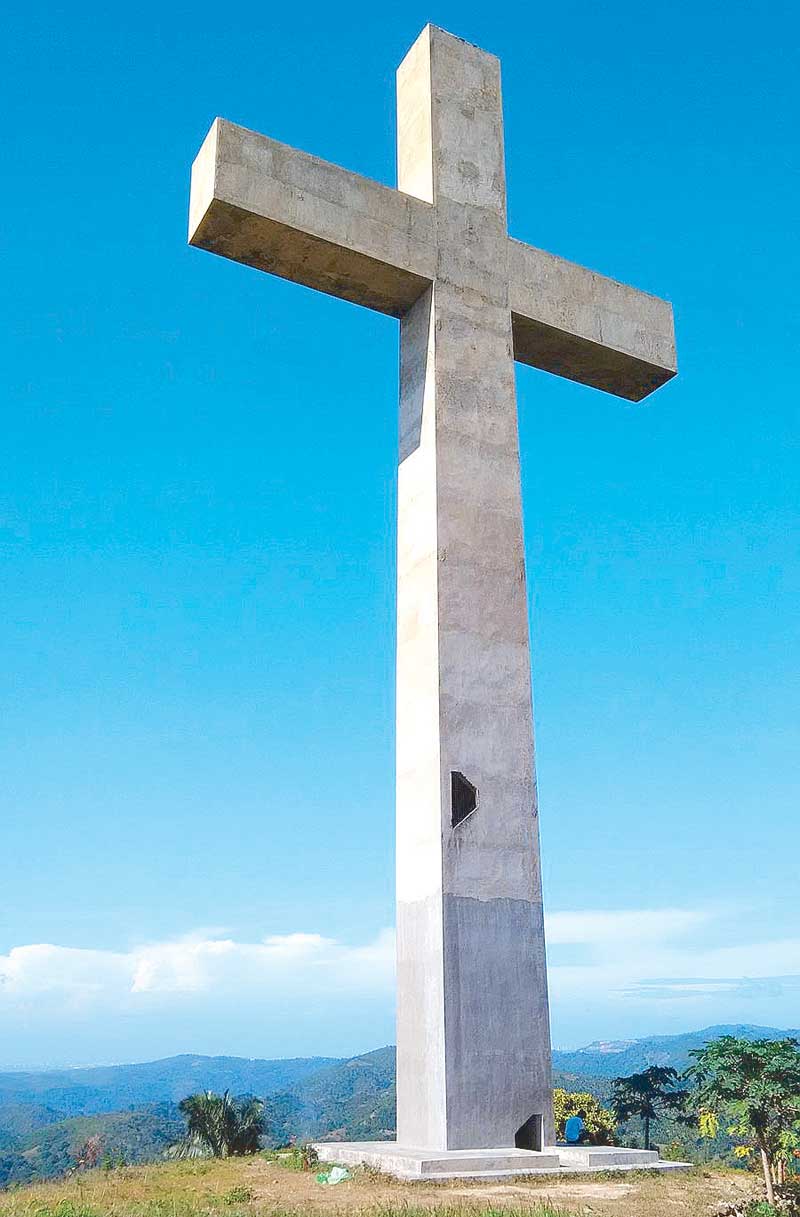
The towering Cross of Triumph serves as the depository of pilgrims’ intentions.
The iconic façade was kept intact except for the image from Spain which was then protected by glass. Barrio folklore tells of one who attempted to break the said vitrine by throwing a small rock. The shield did not break, but instead the pebble boomeranged and almost hit the culprit who cast the stone.
Today, the church has kept its austere retablo with the solitary Santiago de Compostela fiberglass image – designed by veteran festival propmaker Reynaldo Tejero. On the altar table lie the relics of the stone “obtained from the crypt of Holy, Apostolic and Metropolitan Cathedral of Santiago de Compostela, from the remains of the Roman Mausoleum, which houses the urn containing the venerated remains of the Apostle Saint James the Greater and his faithful disciples, Saint Anthanasius and Saint Theodore.”
On the left is the veneration side altar with a reliquary that includes a silver medal with the effigy of Saint James the Greater, which was placed on the urn containing his remains along with his devoted followers.
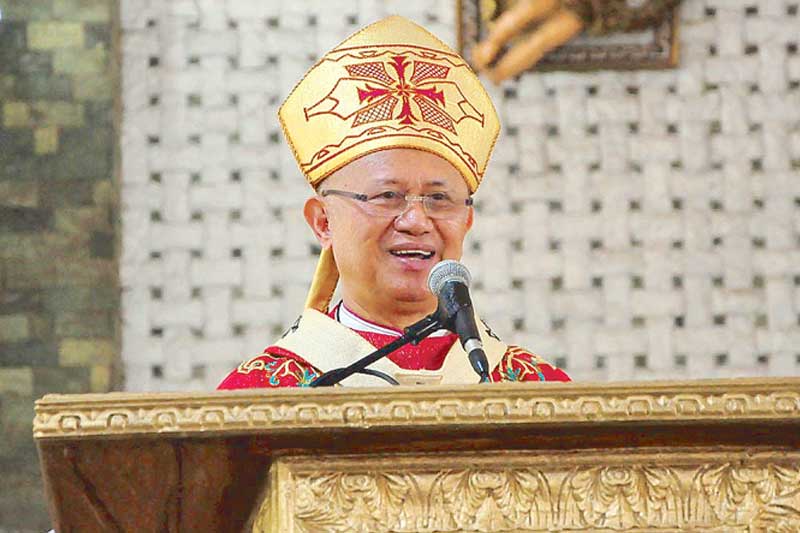
Cebu Archbishop Jose Palma and chancellor and secretary of the cathedral chapter of Santiago de Compostela, Spain.
Meanwhile, temporarily to the right, another significant sight is the soon-to-be-installed Botafumeiro, a suspended censer to swing like a pendulum to dispense smoke and incense. In the old days, this mechanism acted as a healthcare tool that prevented plagues and epidemics as arriving pilgrims were often unwashed and sweaty, with dirt and grime from days of walking. While the Spanish model stands at five feet, the Cebuano version is a whopping 11.5 feet and about 150 kilos.
To the left is the Plaza de Compostela, bearing another image of the patron saint, while the Plaza de Zaragoza on the right is a grass-covered field with a lone statue of Nuestra Señora del Pilar.
We hope that the streets of our islands will one day be filled with pilgrims en route to Compostela, Cebu, full of adventurous challenges, all to seek peace with the Lord and within oneself.
¡Buen Camino!
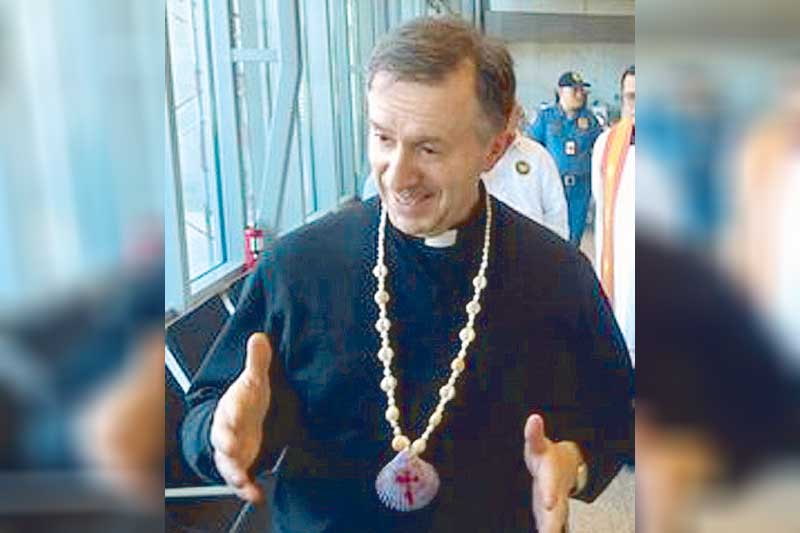
Msgr. Elisardo Temperan Villaverde during the launch of the Cebu Camino last month.
- Latest
- Trending














